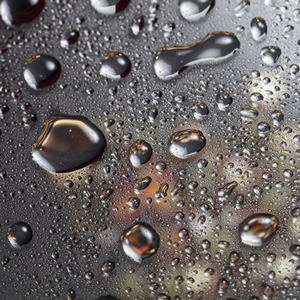Here are a few facts:
The accumulation of condensation will occur when water comes into contact with a colder surface than the surrounding temperature. The water may take the form of actual drops of water or frost.
It is important to first realize that a garage door cannot be as watertight as a home’s entry door, and that it is faced with different situations:
- A garage door must move freely on all 4 sides in order to open.
- A garage door is made up of 4 sections, thus 5 areas as well as the sides of the door will allow air to enter.
- The size of a garage door (9'-16' wide) does not compare to that of entry door (34”). The surface area can easily be 4 to 5 times that of an entry door, and therefore presents a larger surface to cooling.
- A garage holds more humidity than the entryway of a house: snow and ice stuck to a car, fire wood being stored, poor or no ventilation, etc.

Traces of condensation may appear in different locations, on the warm side of the door:
- where sections intersect;
- at the end of each section, behind the weather stripping installed at the header and jambs;
- on the aluminum U-bar (if applicable), on the bottom section of the door.
The Garaga solution:
The source of condensation (cold-hot contact) cannot be eliminated completely, however Garaga has designed their doors to minimize the effects:
- a high-efficiency joint between the sections, coupled with a thermal-break (the interior and exterior skins do not touch);
- rubber weather stripping, made of thermoplastic elastomer, on the bottom section that is flexible enough to adapt to the unevenness of the floor. The U-bar to which the weather stripping is attached can be made of extruded aluminum or PVC. If in aluminum, it can be a heat conductor that can cause condensation if the air in the garage is filled with humidity;
- a wide piece of weatherstripping is attached to the top of the door to compensate for any deficiencies in the exterior weatherstripping (optional on some door models);
- exterior perimeter double-lip weather stripping, higher efficiency than regular weather stripping, is recommended to stop the air infiltration.
Lastly, excess humidity in your garage can be eliminated by leaving the garage door open for a few minutes; cold air will quickly fill the garage, thus lowering humidity. Use a dehumidifier if you have one, especially in the case of newly-built garage.
GARAGA garage doors are very high quality products. Please do not hesitate to contact your Garaga dealer for solutions to any problem that may occur or if you have any general questions.
WARNING: It is not recommended to “crush” the weather stripping against the door as it will prevent smooth operation of the door. For a smooth operation of the weather stripping, we recommend the use of a silicon-based lubricant. Do not use any petroleum-based oils.
| Outside temperature (°F/°C) | Maximum tolerable humidity (%) |
| -20 / -29 | 20 |
| -10 / -23 | 25 |
| 0 / -18 | 30 |
| 10 / -12 | 35 |
| 10 / -12 | 35 |
| 19 / -7 | 40 |






